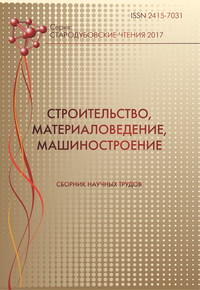Mathematical modeling of austenite transformation kinetics during cooling of lowcarbon steel considering the effect of strain
Keywords:
mathematical modeling, phase transformations, austenite steel, deformationAbstract
Annotation. Purpose. A study of high-temperature deformation of low-carbon steel impact on the kinetics of austenite transformations and a structure formation at different cooling rates using computer simulation. Methods. The main research tool is a physically based computer model describing the kinetics of austenite transformation in steel during cooling. As research material selected low-carbon steel 15. Findings. Here was modeled a process, describing the transformation kinetics of austenite in arbitrary composition steels, allowing also qualitatively and quantitatively predict the metal structure formation. Using as an example a lowcarbon low-alloyed steel the feasibility of the model to predict the impact of pre-high-temperature deformation on the steel structure during the phase transformation was demonstrated. It was shown an increasing of ferrite transformation rate in the deformed steel which causes ferrite grain refinement and prevent a formation of low-carbon martensite in the final structure. Originality. Using a computer model quality and quantity effects austenite of pre-strain at 930 °C in the steel 15 were studied. It is found that predeformation with a degree of 50% can in the 1.5 - 2.0 (depending on the cooling rate) times refines ferrite grain size and prevents the formation of low-carbon martensite. The degree of pre-deformation effect on the kinetics of austenite transformation decreases with a decrease in the cooling rate. Practical value. Computer simulation of supercooled austenite transformation processes allows you to quickly and cost-effectively get the information necessary for thermal and thermo-mechanical processing technologies development and improvement. In particular it is shown that when the formation of martensite and bainite structures in the conditions of accelerated cooling is not desirable, preliminary deformation of a low carbon low alloyed steel at a temperature slightly higher than A3 can significantly reduce their quantity while significantly (up to 1.5 – 2.0 times) ferrite grains refinement.References
Golod V. M. Vychislitel'naja termodinamika v materialovedenii [Computational Thermodynamics in Materials Engineering] / V. M. Golod, K. D. Savel'ev. – St. Petersburg: Publishing of the Polytechnic University, 2010. – 217 p. (in Russian)
Golikov P. A. Raschjot kojefficienta diffuzii ugleroda v staljah i ego prilozhenie v modelirovanii fazovyh prevrashhenij i nauglerozhivanija [Calculation of carbon diffusion coefficient in steel and its application in modeling of phase transformations and carburizing]: Dis. cand. tehn. Science / P. A. Golikov. – St. Petersburg, 2011. - 176 p. (in Russian)
Komp'juternoe modelirovanie fazovyh prevrashhenij v kompleksno legirovannoj stali [Computer modeling of phase transformations in the complex alloy steel] / A. I. Trocan, V. V. Kaverinsky, I. L. Brodecky, Z. P. Suhenko // Stroitel'stvo, materialovedenie, mashinostroenie: Starodubovskie chtenija 2016. [Construction, materials science, mechanical engineering: Starodubov reading in 2016.] – Dnepropetrovsk: PGSA, 2016. - Vol. 89. – pp. 177 – 181. (in Russian)
Kaverinsky V. V. Computer program for modeling of phase transformations. – Certificate of copyright registration number 70573 from 02.22.2017.
Modelirovanie γ ® α-prevrashhenija v staljah [Modeling of γ®α-transformations in steels] A. A. Vasil'ev, D. F. Sokolov, N. G. Kolbasnikov, S. F. Sokolov // Fizika tvjordogo tela [Solid State Physics]. – 2012. – V. 54. – Vol. 8. – pp. 1565 – 1574. (in Russian)
Modelirovanie vlijanija sostava trubnyh stalej i rezhima termicheskoj obrabotki na kinetiku raspada austenita i strukturu ferrita [Modeling of the effect of pipe steels composition and heat treatment conditions on the kinetics of austenite decay and ferrite structure] / N. Ju. Zolotorevskij, E. V. Nesterova, E. I. Hlusova et. all. // Voprosy materialovedenija [Materials Questions]. – 2011. - № 3. – pp. 38 – 52. (in Russian)
Bhadeshia H.K.D.H. Bainite in steels / H.K.D.H. Bhadeshia // The Institute of Materials: London, UK. – 1992. – 468 p.
Influence of deformation on austenite to ferrite transformation in low carbon steels: experimental approach and modeling [Text] / S. Lacroix, Y. T. Breche, M. Veron e. a. // Austenite Formation and Decomposition. – Warrendale, PA, 2003. – P. 367 – 379.
Vasilyev A. Carbon diffusion coefficient in complexly alloyed austenite [Text] / A. Vasilyev // Detroit: Proc. MS&T, 2007. – P. 537 – 551.
Yoshie A. Formation of flow stress on Nb added steels by considering work-hardening and dynamic recovery [Text] / A. Yoshie // ISIJ Int. – 1996. – V. 36. – P. 467 – 473.
Downloads
Published
Issue
Section
License
Редакція Видання категорично засуджує прояви плагіату в статтях та вживає всіх можливих заходів для його недопущення. Плагіат розглядається як форма порушення авторських прав і наукової етики.
При виявлені у статті більш ніж 25% запозиченого тексту без відповідних посилань та використання лапок, стаття кваліфікується як така, що містить плагіат. У цьому випадку стаття більше не розглядається редакцією, а автор отримує перше попередження.
Автори, в статтях яких повторно виявлено плагіат, не зможуть публікуватися в усіх журналах Видавництва ДВНЗ «Придніпровська державна академія будівництва та архітектури».
Автори, які публікуються у цьому журналі, погоджуються з наступними умовами:
- Автори залишають за собою право на авторство своєї роботи та передають журналу право першої публікації цієї роботи на умовах ліцензії Creative Commons Attribution License, котра дозволяє іншим особам вільно розповсюджувати опубліковану роботу з обов'язковим посиланням на авторів оригінальної роботи та першу публікацію роботи у цьому журналі.
- Автори мають право укладати самостійні додаткові угоди щодо неексклюзивного розповсюдження роботи у тому вигляді, в якому вона була опублікована цим журналом (наприклад, розміщувати роботу в електронному сховищі установи або публікувати у складі монографії), за умови збереження посилання на першу публікацію роботи у цьому журналі.
- Політика журналу дозволяє і заохочує розміщення авторами в мережі Інтернет (наприклад, у сховищах установ або на особистих веб-сайтах) рукопису роботи, як до подання цього рукопису до редакції, так і під час його редакційного опрацювання, оскільки це сприяє виникненню продуктивної наукової дискусії та позитивно позначається на оперативності та динаміці цитування опублікованої роботи (див. The Effect of Open Access).

